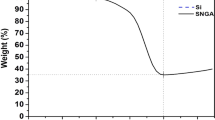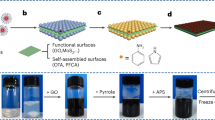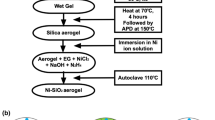Abstract
Batteries, fuel cells and solar cells, among many other high-current-density devices, could benefit from the precise meso- to macroscopic structure control afforded by the silica sol–gel process. The porous materials made by silica sol–gel chemistry are typically insulators, however, which has restricted their application. Here we present a simple, yet highly versatile silica sol–gel process built around a multifunctional sol–gel precursor that is derived from the following: amino acids, hydroxy acids or peptides; a silicon alkoxide; and a metal acetate. This approach allows a wide range of biological functionalities and metals—including noble metals—to be combined into a library of sol–gel materials with a high degree of control over composition and structure. We demonstrate that the sol–gel process based on these precursors is compatible with block-copolymer self-assembly, colloidal crystal templating and the Stöber process. As a result of the exceptionally high metal content, these materials can be thermally processed to make porous nanocomposites with metallic percolation networks that have an electrical conductivity of over 1,000 S cm−1. This improves the electrical conductivity of porous silica sol–gel nanocomposites by three orders of magnitude over existing approaches, opening applications to high-current-density devices.
This is a preview of subscription content, access via your institution
Access options
Subscribe to this journal
Receive 12 print issues and online access
$259.00 per year
only $21.58 per issue
Buy this article
- Purchase on Springer Link
- Instant access to full article PDF
Prices may be subject to local taxes which are calculated during checkout




Similar content being viewed by others
References
Brinker, C. J. & Scherer, G. W. Sol–Gel Science: The Physics and Chemistry of Sol–Gel Processing (Academic, 1990).
Iler, R. K. The Chemistry of Silica: Solubility, Polymerization, Colloid and Surface Properties, and Biochemistry (Wiley, 1979).
Aizenberg, J. et al. Skeleton of Euplectella sp.: Structural hierarchy from the nanoscale to the macroscale. Science 309, 275–278 (2005).
Thimsen, E., Leformal, F., Graetzel, M. & Warren, S. C. Influence of plasmonic Au nanoparticles on the photoactivity of Fe2O3 electrodes for water splitting. Nano Lett. 11, 35–43 (2011).
Warren, S. C. & Thimsen, E. Plasmonic solar water splitting. Energy Environ. Sci. 5, 5133–5146 (2012).
Atwater, H. A. & Polman, A. Plasmonics for improved photovoltaic devices. Nature Mater. 9, 205–213 (2010).
Stöber, W., Fink, A. & Bohn, E. Controlled growth of monodisperse silica spheres in the micron size range. J. Colloid Interf. Sci. 26, 62–69 (1968).
Yanagisawa, T., Shimizu, T., Kuroda, K. & Kato, C. Trimethylsilyl derivatives of alkyltrimethylammonium-kanemite complexes and their conversion to microporous silica materials. Bull. Chem. Soc. Jpn 63, 1535–1537 (1990).
Kresge, C. T., Leonowicz, M. E., Roth, W. J., Vartuli, J. C. & Beck, J. S. Ordered mesoporous molecular sieves synthesized by a liquid-crystal template mechanism. Nature 359, 710–712 (1992).
Templin, M. et al. Organically modified aluminosilicate mesostructures from block copolymer phases. Science 278, 1795–1798 (1997).
Ryan, J. V. et al. Electronic connection to the interior of a mesoporous insulator with nanowires of crystalline RuO2 . Nature 406, 169–172 (2000).
Morris, C. A., Anderson, M. L., Stroud, R. M., Merzbacher, C. I. & Rolison, D. R. Silica sol as a nanoglue: Flexible synthesis of composite aerogels. Science 284, 622–624 (1999).
Watcharotone, S. et al. Graphene-silica composite thin films as transparent conductors. Nano Lett. 7, 1888–1892 (2011).
Wang, X., Zhi, L. & Mullen, K. Transparent, conductive graphene electrodes for dye-sensitized solar cells. Nano Lett. 8, 323–327 (2007).
Kang, B. & Ceder, G. Battery materials for ultrafast charging and discharging. Nature 458, 190–193 (2009).
Gasteiger, H. A., Kocha, S. S., Sompalli, B. & Wagner, F. T. Activity benchmarks and requirements for Pt, Pt-alloy, and non-Pt oxygen reduction catalysts for PEMFCs. Appl. Catal. B 56, 9–35 (2005).
Mathias, M. F. et al. Two fuel cell cars in every garage? J. Electrochem. Soc. Interface 14, 24–35 (2005).
Aryanpour, M., Hoffmann, R. & DiSalvo, F. J. Tungsten-doped titanium dioxide in the rutile structure: Theoretical considerations. Chem. Mater. 21, 1627–1635 (2009).
Rolison, D. R. Catalytic nanoarchitectures–the importance of nothing and the unimportance of periodicity. Science 299, 1698–1701 (2003).
Terry, K. W., Lugmair, C. G. & Tilley, T. D. Tris(tert-butoxy)siloxy complexes as single-source precursors to homogeneous zirconia- and hafnia-silica materials. An alternative to the sol–gel method. J. Am. Chem. Soc. 119, 9745–9756 (1997).
Rupp, W., Husing, N. & Schubert, U. Preparation of silica-titania xerogels and aerogels by sol–gel processing of new single-source precursors. J. Mater. Chem. 12, 2594–2596 (2002).
Garcia, C., Zhang, Y. M., DiSalvo, F. & Wiesner, U. Mesoporous aluminosilicate materials with superparamagnetic γ-Fe2O3 particles embedded in the walls. Angew. Chem. Int. Ed. 42, 1526–1530 (2003).
Luechinger, M., Kienhofer, A. & Pirngruber, G. D. Immobilized complexes of metals with amino acid ligands—a first step towards the development of new biomimetic catalysts. Chem. Mater. 18, 1330–1336 (2006).
Schubert, U. Preparation of metal oxide or metal nanoparticles in silica via metal coordination to organofunctional trialkoxysilanes. Polym. Int. 58, 317–322 (2009).
Cotton, F. A., Wilkinson, G., Murillo, C. A. & Bochmann, M. Advanced Inorganic Chemistry 6th edn (Wiley, 1999).
Schubert, U., Amberg-Schwab, S. & Breitscheidel, B. Metal complexes in inorganic matrixes. 4. Small metal particles in palladium–silica composites by sol–gel processing of metal complexes. Chem. Mater. 1, 576–578 (1989).
Kakihana, M. & Yoshimura, M. Synthesis and characteristics of complex multicomponent oxides prepared by polymer complex method. Bull. Chem. Soc. Jpn 72, 1427–1443 (1999).
Lenaerts, P. et al. The films of highly luminescent lanthanide complexes covalently linked to an organic–inorganic hybrid material via 2-substituted imidazo[4,5-f]-1,10-phenanthroline groups. Chem. Mater. 17, 5194–5201 (2005).
Sanchez, C., Lebeau, B., Chaput, F. & Boilot, J-P. Optical properties of functional hybrid organic–inorganic nanocomposites. Adv. Mater. 15, 1969–1994 (2003).
Schubert, U., Huesing, N. & Lorenz, A. Hybrid inorganic–organic materials by sol–gel processing of organofunctional metal alkoxides. Chem. Mater. 7, 2010–2027 (1995).
Callebaut, C., Krust, B., Jacotot, E. & Hovanessian, A. G. T-cell activation antigen, CΔ26, as a cofactor for entry of HIV in CΔ4+ cells. Science 262, 2045–2050 (1993).
Dong, D., Jiang, S., Men, Y., Ji, X. & Jiang, B. Nanostructured hybrid organic–inorganic lanthanide complex films produced in situ via a sol–gel approach. Adv. Mater. 12, 646–649 (2000).
Merbach, A. E. & Tóth, É. The Chemistry of Contrast Agents in Medical Magnetic Resonance Imaging (Wiley, 2001).
Jiang, S. P. A review of wet impregnation—an alternative method for the fabrication of high performance and nano-structured electrodes of solid oxide fuel cells. Mater. Sci. Eng. A-Struct. 418, 199–210 (2006).
Pike, G. E. & Seager, C. H. Electrical properties and conduction mechanisms of Ru-based thick-film (cermet) resistors. J. Appl. Phys. 48, 5152–5169 (1977).
Van der Pauw, L. J. A method of measuring specific resistivity and Hall effect of discs of arbitrary shape. Phil. Res. Rep. 13, 1–9 (1958).
Abeles, B., Sheng, P., Coutts, M. D. & Arie, Y. Structural and electrical properties of granular metal films. Adv. Phys. 24, 407–461 (1975).
Terrill, R. H. et al. Monolayers in three dimensions: NMR, SAXS, thermal, and electron hopping studies of alkanethiol stabilized gold clusters. J. Am. Chem. Soc. 117, 12537–12548 (1995).
Zabet-Khosousi, A. & Dhirani, A-A. Charge transport in nanoparticle assemblies. Chem. Rev. 108, 4072–4124 (2008).
Joo, S. H. et al. Thermally stable Pt/mesoporous silica core-shell nanocatalysts for high-temperature reactions. Nature Mater. 8, 126–131 (2009).
Warren, S. C. et al. Ordered mesoporous materials from metal nanoparticle-block copolymer self-assembly. Science 320, 1748–1752 (2008).
Raney, M. Method of producing finely-divided nickel. US patent 1,628,190 (1927).
Erlebacher, J., Aziz, M. J., Karma, A., Dimitrov, N. & Sieradzki, K. Evolution of nanoporosity in dealloying. Nature 410, 450–453 (2001).
Sandler, J. et al. Development of a dispersion process for carbon nanotubes in an epoxy matrix and the resulting electrical properties. Polymer 40, 5967–5971 (1999).
Sandler, J. K. W., Kirk, J. E., Kinloch, I. A., Shaffer, M. S. P. & Windle, A. H. Ultra-low electrical percolation threshold in carbon-nanotube-epoxy composites. Polymer 44, 5893–5899 (2003).
Kinoshita, K. Particle size effects for oxygen reduction on highly dispersed platinum in acid electrolytes. J. Electrochem. Soc. 137, 845–848 (1990).
Pantea, D., Darmstadt, H., Kaliaguine, S., Sümmchen, L. & Roy, C. Electrical conductivity of thermal carbon blacks: Influence of surface chemistry. Carbon 39, 1147–1158 (2001).
Becerril, H. A. et al. Evaluation of solution-processed reduced graphene oxide films as transparent conductors. ACS Nano 2, 463–470 (2008).
Attard, G. S. et al. Mesoporous platinum films from lyotropic liquid crystalline phases. Science 278, 838–840 (1997).
Yamauchi, Y., Yokoshima, T., Momma, T., Osaka, T. & Kuroda, K. Fabrication of magnetic mesostructured nickel–cobalt alloys from lyotropic liquid crystalline media by electroless deposition. J. Mater. Chem. 14, 2935–2940 (2004).
Carrette, L., Friedrich, K. A. & Stimming, U. Fuel cells: Principles, types, fuels, and applications. ChemPhysChem 1, 162–193 (2000).
Avnir, D., Braun, S., Lev, O. & Ottolenghi, M. Enzymes and other proteins entrapped in sol–gel materials. Chem. Mater. 6, 1605–1614 (1994).
Acknowledgements
The authors acknowledge support of this research by the DOE (DE-FG02-03ER46072) and the NSF through single investigator awards (DMR-0605856 and DMR-1104773). We further acknowledge use of facilities of the Cornell Center for Materials Research (CCMR) with financial support from the Materials Research Science and Engineering Center programme of the National Science Foundation (cooperative agreement DMR 0520404). X-ray diffraction at the Cornell High Energy Synchrotron Source (CHESS) is supported by the National Science Foundation under award DMR-0225180. S.C.W. acknowledges support from the EPA STAR fellowship programme. We thank Debra Rolison for helpful discussions.
Author information
Authors and Affiliations
Contributions
S.C.W. designed the sol–gel chemistry and carried out most experiments and data analysis. M.R.P. and S.C.W. synthesized the sol–gel precursors and hybrid films. A.M.A. and S.C.W. synthesized the block-copolymer hybrids. M.K. carried out colloidal crystal templating. E.H. and T.S. synthesized Stöber-type particles. A.A.B. and S.C.W. carried out EDX. S.C.W. carried out electrical conductivity measurements. H.A. etched silica. H.S. and J.W. carried out Raman measurements. Z.L., A.M.A. and S.C.W. prepared and analysed the block-copolymer hybrids. J.S. and S.C.W. synthesized the block copolymers. U.W-Z. and J.W.Z. carried out solid-state NMR measurements. S.C.W. and U.W. wrote the manuscript and all authors contributed to revisions. M.G., F.J.D. and U.W. supervised the research.
Corresponding author
Ethics declarations
Competing interests
The authors declare no competing financial interests.
Supplementary information
Supplementary Information
Supplementary Information (PDF 1390 kb)
Rights and permissions
About this article
Cite this article
Warren, S., Perkins, M., Adams, A. et al. A silica sol–gel design strategy for nanostructured metallic materials. Nature Mater 11, 460–467 (2012). https://doi.org/10.1038/nmat3274
Received:
Accepted:
Published:
Issue Date:
DOI: https://doi.org/10.1038/nmat3274
This article is cited by
-
Molecular aspects on the amino acid-mediated sol–gel process of tetramethoxysilane in water
Journal of Sol-Gel Science and Technology (2019)
-
Reinforced silica-carbon nanotube monolithic aerogels synthesised by rapid controlled gelation
Journal of Sol-Gel Science and Technology (2018)
-
Fabrication of Conductive Macroporous Structures Through Nano-phase Separation Method
Electronic Materials Letters (2018)
-
Silver metal nano-matrixes as high efficiency and versatile catalytic reactors for environmental remediation
Scientific Reports (2017)
-
Tunable morphology for silica/poly(acrylic acid) hybrid nanoparticles via facile one-pot synthesis
Macromolecular Research (2016)



